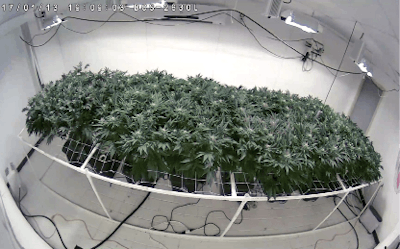
In a given day, East Lansing, Mich.-based Alef Agriculture records more than 1,000 data points from its 2,400-square-foot cannabis cultivation facility, says CEO Ryan Moloney. Much of the data includes critical growth factors, such as atmospheric conditions, as well as market data.
As the cannabis industry becomes more mainstream, advanced and competitive, the use of data collection and analytics methods commonly found in the corporate world are sure to follow. Data provides insights into quality, efficiency, market trends and overall financial performance. Companies that measure, analyze and act on results to cut costs and increase yields, among other things, will gain an advantage in the market by increasing profit margins and even product quality.
For now, it seems at least some growers are still using fairly rudimentary tools to track data, though that could change quickly as they scale up their operations. Indeed, the volumes of information available from utilities, environmental controls, consumer buying behaviors and even hand-written observations are significant.
Cannabis Business Times spoke with three growers, including Moloney, who shared some of their best practices for data collection and analysis, in addition to the tools they’re using or considering.
How Alef Agriculture Ties Data to the Marketplace
Included in the 1,000 or so data points collected by Alef Agriculture are atmospheric conditions, such as temperature, CO2 parts per million, nutrient levels and lighting, as well as rhizosphere conditions to monitor data related to Alef Agriculture’s deep water culture method. For deep water culture, Moloney tracks variables such as electric conductivity (EC), pH and the water’s oxygen content.
He can watch in real time how the plant is functioning in the solution using meters that feed information back electronically.
“Tightly tracking our nutrient solution data not only allows us to grow healthier plants, but we’re also able to get a better grasp on controlling our costs and pushing our quality,” says Moloney. “While we are a small facility when compared to more developed markets, controlling costs is something that has proven to be a major stumbling block for other companies when scaling. So, by closely monitoring our variables, we can see where we are wasting money and make more accurate projections for future growth,” he adds.
“We haven’t stopped at our nutrient solution either. While many cultivators try to maintain CO2 levels around 1500 ppm [parts per million] during most of the flower cycle, we found that by starting flower at 800 ppm and moving to 1200 ppm for the bulking weeks, then dropping back incrementally to 300 ppm to finish the plants not only produces a better product, but allowed us to cut CO2 consumption by nearly 20 percent,” he explains.
Moloney also tracks information related to market trends. “We’re looking for correlations – that’s what this all comes down to,” Moloney says. For example, Moloney compares how a higher-quality product will impact costs and compares that to the market demand to determine which investments make sense, he says. Each quarter, Moloney hires a close friend who is a Ph.D. student and researcher at Michigan State University to conduct market research gathered from the website Weedmaps.com.
Alef Agriculture, which has forecasted 2017 revenues of $325,000, is currently focused on data gathering; Moloney wants to make sure he’s measuring an adequate sample size of flowering periods under normal conditions before moving to the analytics phase. For example, an air conditioning unit blew out during the summer, which would have impacted the data quality.
After the data collection is completed, his friend at Michigan State is going to help him analyze the data using similar measurements he applied while working on his dissertation.
For now, Moloney says he plans to continue using Excel spreadsheets to log the data and outside resources to analyze the information, but eventually the company could implement more sophisticated analytics methods, such as software.
“That’s a bridge we’ll have to cross when we start to dig into what we really have here,” Moloney says. “I can’t say we won’t or we will. I believe as we … scale and move into a national brand and national-size company, we’re going to need some sort of company-internal [analytics software], but that could be four to five years from now.”

Photo courtesy Alef Agriculture
Leaf on the Mesa Targets Waste, Efficiency
Whether it’s the type of nutrient, pesticide or waste, Pueblo, Colo.-based Leaf on the Mesa keeps painstakingly detailed records, says cultivation director Vince Hanson. The company keeps both a written and electronic record of cultivation-related data. Its primary electronic database is the state of Colorado’s Marijuana Enforcement Tracking Reporting Compliance (METRC) system. METRC is an inventory-tracking system required by the state that tracks every plant from seed to its point of sale via RFID tags or bar codes.
It’s a necessary evil, but it’s also a useful resource. METRC provides the ability to enter the amount of nutrients or pesticides used in the field and will calculate the percentages distributed per plant, Hanson says.
This ensures every plant is receiving consistent schedules for optimal growth and helps with budgeting. For example, data tracking helped the team identify a broken nutrient meter by comparing the actual amount of nutrient used to the desired electrical conductivity (EC) value.
“That helps us with budgeting because you know where you’re at with usage and how much your plants use, so you can tell what’s working ... especially if you’re doing side-by-side nutrient trials,” Hanson says.
The information entered into METRC also verifies that only state- and EPA-approved pesticides are being used.
Hanson also uses the state utility website to his advantage. He can log on to the Black Hills Energy website to view real-time data on the company’s energy use. He uses the information to monitor energy spikes and take corrective actions, such as scheduling lights to come on at specific times to avoid spikes, he says.

R. Greenleaf ‘Writes Down Everything’
When in doubt, write it down, advises Jacob White, master grower at R. Greenleaf Organics in Albuquerque, N.M.
“Pretty much anything I can write down usually pays off somewhere down the road,” he says. “There are times where we track data without having a specific purpose for the data.”
White logs data on just about anything that can impact plant quality, including lighting, pesticide applications and nutrient information. R. Greenleaf manages three different farms with slightly different lighting systems, for example. The smallest room has eight lights, while the largest room has 15 lights, so it’s difficult to get an apples-to-apples comparison on yields per plant.
Instead, White tracks lighting efficiency by grams per watt. The advantage: He can determine the impact that lighting has on yields more accurately than simply tracking yield per plant. With greater visibility into lighting efficiency, White has seen yields more than double per watt since the company’s inception.

“Getting good, accurate data has been very helpful for the process,” he says. “We started to see more empirical data vs. anecdotal data. Over time, that led us to making more responsible decisions and improving what we were doing by leaps and bounds.”
White’s philosophy of writing down every data value whenever possible has paid off even when he wasn’t certain it served a purpose. For instance, he measured the runoff once per week from each plant whenever he irrigated.
“Data collection is the differencemaker, whether someone is growing as a hobby or a professional.” — Jacob White, R. Greenleaf Organics
“I figured over time I could find an acceptable rate for different strains as far as how much nutrient they could tolerate or require,” he said. “I didn’t have an immediate purpose for it, but over time I was able to get enough data to put together a plan. That kind of data has helped when we got into maybe a deficiency on a plant and maybe with the knowledge of the inputs we could find if a mistake was made.”
In fact, data tracking is so critical that White says he’s most impressed with new hires who bring a notebook with them on their first day of work.

“It’s so important because you would have no hope of finding a lot of issues unless you had a perfect memory, which most people don’t,” he says. “Data collection is the difference-maker, whether someone is growing as a hobby or a professional.”
The handwritten data is eventually entered into an Excel spreadsheet. But White hopes to eventually have a more sophisticated system that can provide more in-depth analysis.
In December 2016, he was evaluating a system, but said it didn’t work well with the state-mandated BioTrackTHC seed-to-sale tracking software. He would like to see a system that, in addition to tracking the movement of plants, also allows him to program nutrient schedules, log pesticide applications and pull reports on various other variables, such as temperature, humidity and irrigation measurements.
“What we’re doing now is a very rudimentary version of that,” he said. “I think we will see that level of analytics in the cannabis industry this coming year – if we haven’t already. We’ve seen some impressive data collecting in other places. We’re still a small market here in New Mexico.”


















